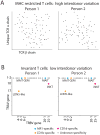Donor Unrestricted T Cells: A Shared Human T Cell Response
- PMID: 26297792
- PMCID: PMC4549802
- DOI: 10.4049/jimmunol.1500943
Donor Unrestricted T Cells: A Shared Human T Cell Response
Abstract
The now-famous term "restriction" derived from experiments in which T cells from Donor A failed to recognize Ags presented by cells from Donor B. Restriction results from interdonor variation in MHC genes. Donor restriction dominates immunologists' thinking about the T cell response because it governs organ transplantation and hinders the discovery of disease-associated Ags. However, other T cells can be considered "donor unrestricted" because their targets, CD1a, CD1b, CD1c, CD1d, or MR1, are expressed in a similar form among all humans. A striking feature of donor unrestricted T cells is the expression of invariant TCRs with nearly species-wide distribution. In this article, we review new evidence that donor unrestricted T cells are common in humans. NKT cells, mucosa-associated invariant T cells, and germline-encoded mycolyl-reactive T cells operate outside of the familiar principles of the MHC system, providing a broader picture of T cell function and new opportunities for therapy.
Copyright © 2015 by The American Association of Immunologists, Inc.
Figures


References
-
- Zinkernagel RM, Doherty PC. Restriction of in vitro T cell-mediated cytotoxicity in lymphocytic choriomeningitis within a syngeneic or semiallogeneic system. Nature. 1974;248:701–702. - PubMed
-
- Zinkernagel RM. The Nobel Lectures in Immunology. The Nobel Prize for Physiology or Medicine, 1996. Cellular immune recognition and the biological role of major transplantation antigens. Scand J Immunol. 1997;46:421–436. - PubMed
-
- Han M, Hannick LI, DiBrino M, Robinson MA. Polymorphism of human CD1 genes. Tissue Antigens. 1999;54:122–127. - PubMed
-
- Nikolich-Zugich J, Slifka MK, Messaoudi I. The many important facets of T-cell repertoire diversity. Nat Rev Immunol. 2004;4:123–132. - PubMed
Publication types
MeSH terms
Substances
Grants and funding
LinkOut - more resources
Full Text Sources
Other Literature Sources
Medical
Research Materials

